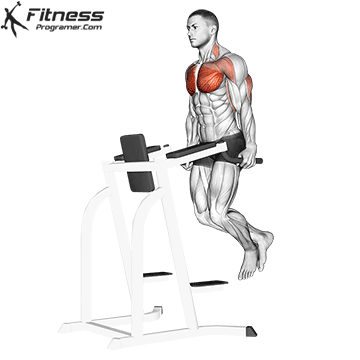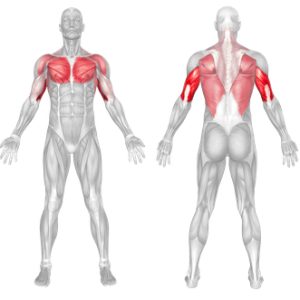Chest Dips Overview
Chest dips are a bodyweight exercise that target the chest, triceps, and shoulders. They are performed using parallel bars or dip bars, and involve lowering your body by bending your elbows and leaning forward slightly, and then pushing yourself back up by straightening your arms.
How to Perform Chest Dips

Setup
- Position Yourself: Place your hands on the parallel bars, keeping your arms straight and your body slightly tilted forward. Your feet should be off the ground, and your body should be in an upright or slightly forward lean position, depending on your focus.
- Grip: Grasp the bars firmly with your palms facing inward and your elbows slightly bent to start.
- Leg Position: Keep your legs bent at the knees and feet together for stability, or extend them straight out for more difficulty.
Execution
- Lower Your Body: Slowly lower your body by bending your elbows, keeping your upper body slightly leaning forward. Lower yourself until your upper arms are parallel to the floor or slightly below.
- Engage the Chest: Focus on squeezing your chest muscles as you lower your body. This forward lean emphasizes the chest more than the triceps.
- Press Up: Push yourself back up by straightening your arms, returning to the starting position.
- Repeat: Perform the desired number of repetitions, maintaining control throughout the movement.
Coach Tips
- Slow and Controlled: Perform each rep slowly and with control to maximize muscle engagement. Focus on the stretch at the bottom and the squeeze at the top.
- Mind-Muscle Connection: Concentrate on feeling the chest muscles working throughout the movement, especially during the lowering phase.
- Use Progressive Overload: As you get stronger, you can add weight using a dip belt to continue progressing and building muscle.
- Warm Up Properly: Ensure your shoulders and chest are warmed up before performing dips to prevent injuries.
Common Mistakes to Avoid
- Not Leaning Forward Enough: For chest activation, make sure to lean forward slightly as you lower your body. This helps target the chest muscles. If you stay too upright, the focus will shift to the triceps.
- Flared Elbows: Keep your elbows close to your body to reduce stress on the shoulders and prevent injury.
- Not Going Deep Enough: Ensure you lower yourself sufficiently (at least until your upper arms are parallel to the floor) to maximize chest engagement and muscle activation.
- Locking Elbows at the Top: Avoid locking your elbows at the top of the movement, which can place unnecessary stress on the joints.
Benefits Of Chest Dips
1. Lower Chest Development
- Chest dips are one of the most effective bodyweight exercises for isolating and targeting the lower pectorals. The forward lean during the movement places more stress on the lower part of the pectoralis major, leading to increased strength and size in this region.
2. Triceps Activation
- While the chest is the primary focus, triceps play a secondary role in the pushing motion. The triceps are engaged during the pressing phase of the dip, assisting in extending the arms. This is especially beneficial for anyone seeking to enhance their arm strength for exercises like push-ups, bench presses, and other pressing movements.
3. Functional Strength
- Bodyweight Focus: Being a bodyweight exercise, chest dips are excellent for building functional strength. This kind of strength is essential for daily movements and physical activities, as it trains the body to use its own weight for resistance.
- Pressing Power: As chest dips require you to press your body weight upward, they significantly contribute to improving pressing power. This can enhance performance in other pressing movements like push-ups, overhead presses, and even sports that involve pushing or pressing motions.
- Sport-Specific Benefits: For athletes, dips are especially helpful in sports that involve pushing actions, such as basketball, football, and swimming. Developing strong pushing muscles helps athletes perform better in their respective sports.
4. Increased Range of Motion
- Deep Stretch: Chest dips allow for a greater range of motion compared to many other pressing exercises. As you lower your body, you can stretch the chest muscles more deeply, enhancing muscle flexibility and mobility.
- Better Muscle Contraction: The deep stretch at the bottom of the dip allows for a more complete contraction at the top of the movement, leading to optimal muscle activation. This is key for muscle growth and strengthening.
- Joint Mobility: The deep range of motion in dips also helps improve shoulder and elbow mobility, making it a great exercise for joint health when performed with proper form.
5. Core Activation
- Stabilization: Although chest dips focus on the upper body, they also require significant engagement from the core muscles. Your abs, obliques, and lower back muscles work to stabilize your body during the movement, especially when your legs are off the ground.
- Improved Core Strength: The need to control and stabilize your body while performing dips helps improve core strength. This can translate into better posture and increased performance in other athletic activities that require core stability.
- Balance and Control: As the dip movement requires body control, it helps in developing better overall body balance, especially in exercises that involve upper body pushing or bodyweight movements.
6. Additional Benefits
- Shoulder Health: When performed with proper form, chest dips can actually benefit the shoulders, as the movement promotes joint stability and proper range of motion.
- Versatility: Chest dips can be modified to suit your fitness level. You can start with assisted dips using a dip machine or resistance bands and progress to full bodyweight dips. For increased difficulty, weighted dips can be performed using a dip belt or weighted vest.
Chest Dips Muscles Worked

